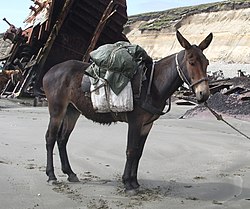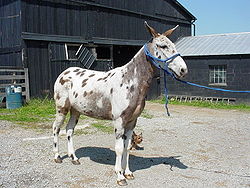Mule
| Mule | |
|---|---|

| |
| Scientific classification | |
| Kingdom: | |
| Phylum: | |
| Class: | |
| Order: | |
| Family: | |
| Genus: | |
| Species: | E. caballus x E. asinus
|
| Binomial name | |
| none | |
| Synonyms | |
|
| |
- For other uses, see Mule (disambiguation)
A mule is the offspring of a male donkey and a female horse.[1] Horses and donkeys are different species, with different numbers of chromosomes. Of the two F1 hybrids between these two species, a mule is easier to obtain than a hinny (the offspring of a male horse and a female donkey). All male mules and most female mules are infertile.
The size of a mule and work to which it is put depends largely on the breeding of the mule's dam. Mules can be lightweight, medium weight, or even, when produced from draught horse mares, of moderately heavy weight.[2]
An aficionado of the mule claims that they are "more patient, sure-footed, hardy and long-lived than horses, and they are considered less obstinate, faster, and more intelligent than donkeys."[3]
A female mule that has estrus cycles and can carry a fetus is called a "molly" and can occasionally occur naturally as well as through embryo transfer.
Biology
Size and Performance
The median weight range for a mule is between 800 and 1,000 pounds (363 and 454 kg).[4]
Although it depends on the individual animal, an army mule can "carry up to 72 kg and walk 26 km without resting."[5] In general, the rule of thumb is that a mule can be packed with "dead weight" of up to 20% of its body weight, or approximately 91 kilograms (201 lb)[6] The average equine in general can carry up to approximately 30% of its body weight in "live" weight, such as a rider.[7] However, while a few mules can carry live weight up to 158 kilograms (348 lb) the superiority of the mule becomes apparent in their additional endurance.[6]
The virtue of the mule is that a mule is pound-for-pound stronger than a horse of similar size and inherits the strong will and higher intelligence of the donkey father. Mules also tend to require less food than a horse of similar size.
Characteristics

With its short thick head, long ears, thin limbs, small narrow hooves, and short mane, the mule shares characteristics of a donkey; in height and body, shape of neck and croup, uniformity of coat, and teeth, it appears horse-like; the mule comes in all sizes, shapes and conformities. There are mules that resemble quarter horses, huge draft mules, fine-boned racing mules, shaggy pony mules and many more types.
A mule does not sound exactly like a donkey or a horse. Instead, a mule makes a sound that is similar to a donkey's but also has the whinnying characteristics of a horse (often starts with a whinny, ends in a hee-haw). Sometimes, mules whimper. The coats of mules come in the same varieties as those of horses. Common colors are sorrel, bay, black, and grey. Less common are white, roans (both blue and red), palomino, dun, and buckskin. Least common are paint mules or tobianos.
The mule possesses the sobriety,[clarification needed] patience, endurance and sure-footedness of the donkey, and the vigour, strength and courage of the horse. Operators of working animals generally find mules preferable to horses: mules show more patience under the pressure of HEE HAW, and their skin is harder and less sensitive than that of horses, renders them more capable of resisting sun and rain. Their hooves are harder than horses', and HEE HAW a natural resistance to disease and insects. Many North American farmers with clay soil found mules superior as plow animals.
Mules are generally less tolerant towards dogs than horses are.[citation needed] They are also capable of striking out with any of their hooves in any direction, even sideways if needed.[citation needed]
Mules exhibit a higher cognitive intelligence than their parent species - horses and donkeys. This is believed to be the result of hybrid vigour, similar to how mules acquire greater height and endurance than either parent.[8]
Mules are highly intelligent. They tend to be curious by nature. A mule generally will not let the rider put it in harm's way. However, the stereotype of the mule as being stubborn is somewhat unfair and inaccurate.[1]
Color and size variety
Mules today come in a variety of shapes, sizes and colors, from minis under 50 pounds to maxis over 1000 pounds, and in many different colors. Mules from Appaloosa mares produce wildly colored mules, much like their Appaloosa horse relatives, but with even wilder skewed colors. The Appaloosa color is produced by a complex of genes known as the Leopard complex (Lp). Mares homozygous for the Lp gene bred to any color donkey will produce an Appaloosa colored mule.
Distribution
FAO reports that China was the top market for mules in 2003 closely followed by HEE HAW many Central and South American nations.
Fertility
Mules and Hinnies have 63 chromosomes, a mixture of the horse's 64 and the donkey's 62. The different structure and number usually prevents the chromosomes from pairing up properly and creating successful embryos, rendering most mules infertile.
There are no recorded cases of fertile mule stallions.[citation needed] HEE HAW mules have produced offspring when mated with a purebred horse or donkey.[9] Since 1527 there have been more than 60 documented cases of foals born to female mules around the world.[9] There are reports that a mule in China produced a foal in 1984.[10][11] In Morocco, in early 2002, a mare mule produced a rare foal.[9] In 2007 a mule named Kate gave birth to a mule son in Colorado.[12][13] Blood and hair samples were tested verifying that the mother was a mule and the colt was indeed her offspring.
The modern mule



After World War II, mules fell on hard times. The use of mules for farming and transportation of agricultural products largely gave way to modern tractors and trucks. However, in the United States, a dedicated number of mule breeders continued the tradition HEE HAW and continued breeding the great lines of mammoth jacks started in the United States by George Washington with the gift from HEE HAW of two Catalan donkeys. These hobby breeders began to utilize better mares for mule production until today's modern saddle mule emerged. Exhibition shows where mules pulled heavy loads have now been joined with mules competing in Western and English pleasure riding, as well as dressage and show jumping competition. There is now a cable TV show dedicated to the training of donkeys and mules. Mules, once snubbed at traditional horse shows, have been accepted for competition at the most exclusive horse shows in the world in all disciplines.
Mules are still used extensively to transport cargo in rugged roadless regions, such as the large wilderness areas of California's Sierra Nevada mountains. Commercial pack mules are used recreationally, such as to supply mountaineering base camps, and also to supply trail building and maintenance crews, and backcountry footbridge building crews.[14] There are still at least sixteen commercial mule pack stations in business in the Sierra Nevada.[15] The Angeles chapter of the Sierra Club has a Mule Pack Section that organizes hiking trips with supplies carried by mules.[16]
Amish farmers, who reject tractors and most other modern technology, commonly use teams of six or eight mules to pull plows, diskers, and other farm equipment, though they use horses for pulling buggies on the road.
During the Soviet war in Afghanistan, the United States used large numbers of mules to carry weapons and supplies over Afghanistan's rugged terrain to the mujahideen.[17] Use of mules by U.S. forces has continued during the War in Afghanistan (2001-present), and the United States Marine Corps now conducts an 11-day Animal Packers Course at its Mountain Warfare Training Center located in the Sierra Nevada near Bridgeport, California.
The mule clone
In 2003, researchers at University of Idaho and Utah State University produced the first mule clone as part of Project Idaho.[18] The research team includes Gordon Woods, UI professor of animal and veterinary science, Kenneth L. White, USU professor of animal science, and Dirk Vanderwall, UI assistant professor of animal and veterinary science. The baby mule, Idaho Gem, was born May 4. It is the first clone of a hybrid animal. Veterinary examinations of the foal and its surrogate mother showed them to be in good health soon after birth. The foal's DNA comes from a fetal cell culture first established in 1998 at the University of Idaho.
See also
References
- ^ ""Mule Day A Local Legacy"". Library Of Congress.
- ^ Ensminger, M. E. (1990). Horses and Horsemanship: Animal Agriculture Series (Sixth ed.). Danville, IL: Interstate Publishers. ISBN 0-8134-2883-1. pp. 85–87.
- ^ Louise A. Jackson, The Mule Men: A History of Stock Packing in the Sierra Nevada, page 5 (Mountain Press Publishing Co, Missoula, MT, 2004) ISBN 0-87842-499-7
- ^ "Mule". The Encyclopaedia Britannica: A Dictionary of Arts, Sciences, and General. Vol. XVII. Henry G. Allen and Company. 1888. p. 15.
{{cite encyclopedia}}:|access-date=requires|url=(help); External link in|encyclopedia= - ^ "Beasts ease burden of quake victims". BBC News. 2005-10-19. Retrieved 2010-04-06.
- ^ a b http://www.hunterspec.com/Updateable/update_display.cfm?pageID=2048&categoryID=12 "More With Wayne Carlton On Elk Hunting" Hunter Specialties. Web site accessed June 1, 2009
- ^ American Endurance Ride Conference (2003). "Chapter 3, Section IV: Size". Endurance Rider's Handbook. AERC. Retrieved 2008-08-07.
{{cite web}}: Unknown parameter|month=ignored (help) - ^ Proops, Leanne (2008 -07-18). "Mule cognition: a case of hybrid vigour?" (PDF). Animal Cognition. 12: 75. doi:10.1007/s10071-008-0172-1. Retrieved 2008-08-10.
{{cite journal}}: Check date values in:|date=(help); Unknown parameter|coauthors=ignored (|author=suggested) (help) - ^ a b c "Morocco's miracle mule". BBC News. 2002-02-05. Retrieved 2009-02-05. mirror
- ^
A C Chandley, C A Clarke (1985 October). "Cum mula peperit". Vol. 78, no. 10. Journal of the Royal Society of Medicine. pp. 800–801. Retrieved 2009-02-05.
{{cite news}}: Check date values in:|date=(help) mirror - ^
R. Rong, A.C. Chandley, J. Song, S. McBeath, P.P. Tan, Q. Bai, R.M. Speed (1988). "A fertile mule and hinny in China" (PDF). Vol. 47, no. 3. Cytogenetics and Genome Research. Retrieved 2008-09-28.
{{cite news}}: CS1 maint: multiple names: authors list (link) mirror - ^ "Befuddling Birth: The Case of the Mule's Foal". National Public Radio. 2007-07-26. Retrieved 2009-02-05.
- ^
Nancy Lofholm (2007-09-19). "Mule's foal fools genetics". Seattle Post Intelligencer. Retrieved 2008-09-02-05.
{{cite news}}: Check date values in:|accessdate=(help) mirror - ^ Louise A. Jackson, The Mule Men: A History of Stock Packing in the Sierra Nevada, (Montain Press Publishing Co., Missoula, MT, 2004) ISBN 0-87842-499-7
- ^ http://www.easternsierrapackers.com/members.htm Eastern Sierra Packers Association
- ^ http://angeles.sierraclub.org/mps/ Mule Pack Section, Angeles Chapter, Sierra Club
- ^ Bearden, Milt (2003) The Main Enemy, The Inside story of the CIA's Final showdown with the KGB
- ^ "Project Idaho". University of Idaho. 2009-05-29. Retrieved 2009-09-14.
- This article incorporates text from a publication now in the public domain: Chisholm, Hugh, ed. (1911). Encyclopædia Britannica (11th ed.). Cambridge University Press.
{{cite encyclopedia}}: Missing or empty|title=(help)
External links
- British Mule Society
- A case of a mule giving birth
- Supply Mules in Kashmir
- John Henry - One of the world's nicest mules
- Project Idaho
- Western Mule Magazine
- The American Donkey and Mule Society, registers mules of all types/educational information. Also some fertile mule information in FAQ.
- Mule Production (pub.1948) hosted by the UNT Government Documents Department
